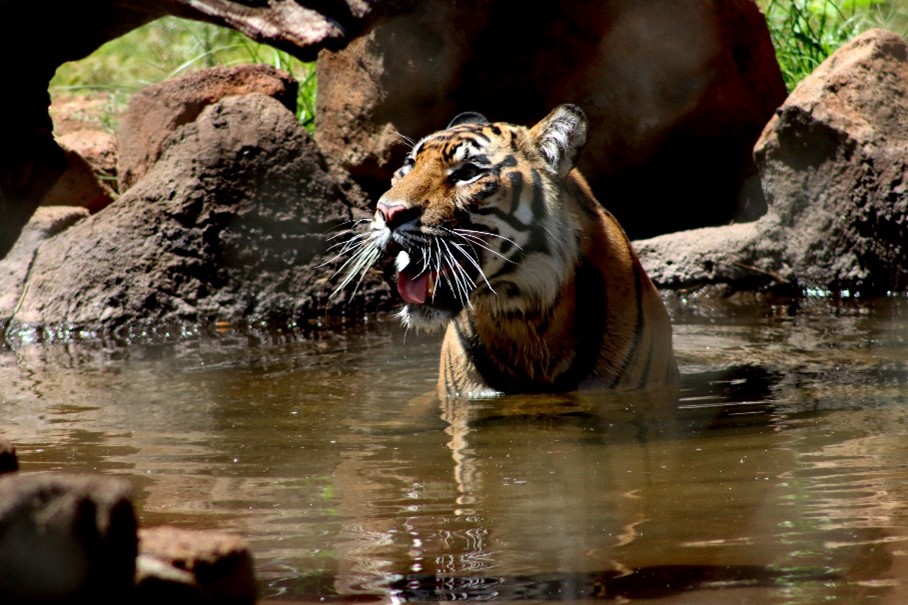Community website by MBC/Ernest Abrams. Call 808-739-9797 for advertising/sponsorship.
Kakaako - Honolulu, Hawaii
News Item- Powered by MBC NewsMaker
Laparoscopic Artificial Insemination Performed On Endangered Sumatran Tiger At Honolulu Zoo
- Tweet

Anala, the Honolulu Zoo’s Sumatran Tiger
WAIKĪKĪ – On September 14, 2023, Anala, a 6-year-old female Sumatran Tiger, was anesthetized to undergo a novel artificial insemination (AI) procedure at the Honolulu Zoo. A team of reproductive specialists from Omaha’s Henry Doorly Zoo performed the surgical procedure with cryopreserved spermatozoa collected from a male Sumatran Tiger at another AZA-accredited zoo. In preparation for this event, Anala’s keepers trained her for voluntary injections and oral medication acceptance. They collected daily fecal samples and observed her behavior changes to track her hormone cycling and determine her ovulation date.
“We are fortunate to be afforded this rare opportunity and extend our sincere appreciation to the Henry Doorly Zoo for sending their team to Honolulu to artificially inseminate Anala,” said Honolulu Zoo veterinarian, Dr. Jill Yoshicedo. “Honolulu Zoo’s veterinary team kept Anala safely under anesthesia while she was transported from the tiger exhibit into the surgery room at the zoo’s veterinary clinic and placed on a ventilator. She received supportive medications, fluids, warming, and leg massages, while her vitals and blood chemistry values were carefully monitored throughout the two hour-long procedure.”
Laparoscopic oviductal AI has only been performed in a handful of tigers. Because this procedure deposits the sperm directly into the female’s oviducts adjacent to where her eggs should ovulate, the numbers of spermatozoa needed are much less – only one million compared to over 100 million with a non-surgical transcervical approach! While AI has led to successful births in multiple other species such as domestic cats, wolves, rhinos, oryx, clouded leopards, and the Tsushima leopard cat, so far AI has led to only four pregnancies in tigers, with an overall pregnancy rate of <20%, and no live births. Due to the limited numbers of Sumatran Tigers remaining in the captive population, the Sumatran Tiger Species Survival Plan (SSP) continues their attempts to achieve conception and live birth through AI matchmaking, in addition to their ongoing physical relocation of suitable matches for reproduction. The benefits of AI include potential offspring regardless of behavioral compatibility or physical location of the genetic parents and the potential for wild males to become genetic founders and improve genetic diversity in the captive population without removing them from the wild.
Anala has made a full recovery from the surgery, and she is back to running along the fence line, jumping on her Boomer ball, and taking it easy in the shade. Pregnancy will be confirmed if her hormone levels remain elevated for two months after conception, or if there is a fetus detectable on abdominal ultrasound. Keeper and veterinary staff continue to work on training Anala for ultrasound presentation at this time. The typical gestation period in the tiger is 92-113 days. If Anala does not become pregnant from the AI procedure, the Honolulu Zoo looks forward to the SSP sending a male tiger as a potential mate in 2024.
Sumatran tigers are the smallest subspecies of tigers and native to the Indonesian island of Sumatra. They are critically endangered with habitat loss, poaching, and loss of prey animals due to deforestation as the biggest threats to their survivability in the wild. There are less than 400 tigers left in their native habitat, and their lifespan typically ranges from 15-20 years.
Questions? Ready for an appointment?
Featured Product/Service
- RELATED LINKS
Calendar
Check out things to do in Kakaako, Hawaii on the calendar of events.News and Newsletters
Keep up with the latest news and happenings in the Kakaako, Hawaii community.Featured Sponsors Offers
Great offers from our sponsors who support the Kakaako, Hawaii Community More...Kakaako, Hawaii Coupons & Discounts
Save money in Kakaako, Hawaii with these coupons.Kakaako, Hawaii Featured Pages
View our directory of feature pages showcasing all the great things Kakaako has to offer.About Kakaako - Honolulu Hawaii
Learn about Kakaako, Hawaii.About Kakaako Hawaii .com
Learn about Kakaako Hawaii .com website and its creator.
Please send questions about this website to
Copyright© 2014 - 2023 KakaakoHawaii.com. All rights reserved.
Terms of Use / Legal Disclaimer / Privacy Statement
Site Designed and Managed by MacBusiness Consulting
Terms of Use / Legal Disclaimer / Privacy Statement
Site Designed and Managed by MacBusiness Consulting
